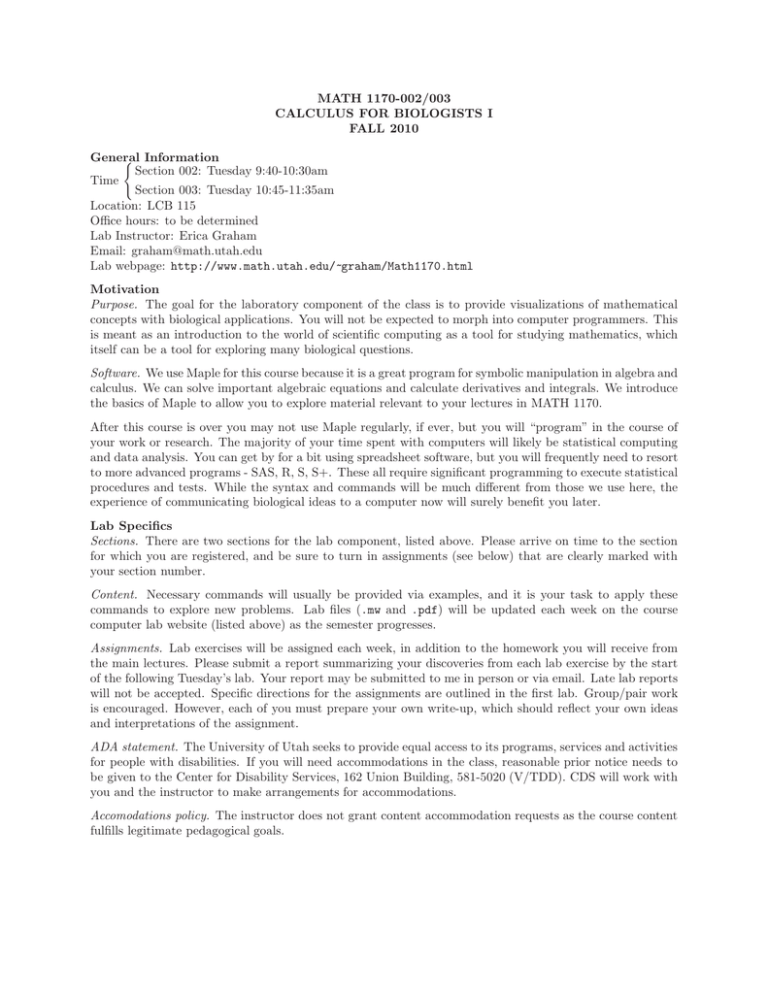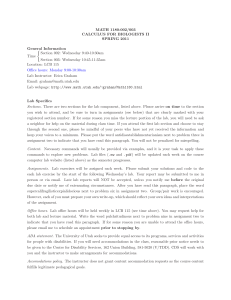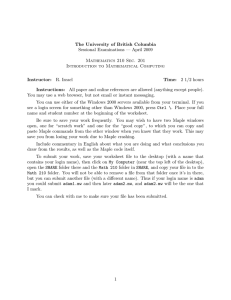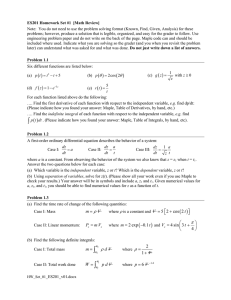MATH 1170-002/003 CALCULUS FOR BIOLOGISTS I FALL 2010 General Information
advertisement

MATH 1170-002/003 CALCULUS FOR BIOLOGISTS I FALL 2010 General ( Information Section 002: Tuesday 9:40-10:30am Time Section 003: Tuesday 10:45-11:35am Location: LCB 115 Office hours: to be determined Lab Instructor: Erica Graham Email: graham@math.utah.edu Lab webpage: http://www.math.utah.edu/~graham/Math1170.html Motivation Purpose. The goal for the laboratory component of the class is to provide visualizations of mathematical concepts with biological applications. You will not be expected to morph into computer programmers. This is meant as an introduction to the world of scientific computing as a tool for studying mathematics, which itself can be a tool for exploring many biological questions. Software. We use Maple for this course because it is a great program for symbolic manipulation in algebra and calculus. We can solve important algebraic equations and calculate derivatives and integrals. We introduce the basics of Maple to allow you to explore material relevant to your lectures in MATH 1170. After this course is over you may not use Maple regularly, if ever, but you will “program” in the course of your work or research. The majority of your time spent with computers will likely be statistical computing and data analysis. You can get by for a bit using spreadsheet software, but you will frequently need to resort to more advanced programs - SAS, R, S, S+. These all require significant programming to execute statistical procedures and tests. While the syntax and commands will be much different from those we use here, the experience of communicating biological ideas to a computer now will surely benefit you later. Lab Specifics Sections. There are two sections for the lab component, listed above. Please arrive on time to the section for which you are registered, and be sure to turn in assignments (see below) that are clearly marked with your section number. Content. Necessary commands will usually be provided via examples, and it is your task to apply these commands to explore new problems. Lab files (.mw and .pdf) will be updated each week on the course computer lab website (listed above) as the semester progresses. Assignments. Lab exercises will be assigned each week, in addition to the homework you will receive from the main lectures. Please submit a report summarizing your discoveries from each lab exercise by the start of the following Tuesday’s lab. Your report may be submitted to me in person or via email. Late lab reports will not be accepted. Specific directions for the assignments are outlined in the first lab. Group/pair work is encouraged. However, each of you must prepare your own write-up, which should reflect your own ideas and interpretations of the assignment. ADA statement. The University of Utah seeks to provide equal access to its programs, services and activities for people with disabilities. If you will need accommodations in the class, reasonable prior notice needs to be given to the Center for Disability Services, 162 Union Building, 581-5020 (V/TDD). CDS will work with you and the instructor to make arrangements for accommodations. Accomodations policy. The instructor does not grant content accommodation requests as the course content fulfills legitimate pedagogical goals. Introduction to Math Computing Logging in to your math account 1. On the blue welcome screen, make sure the Java desktop is selected. To do this, click and hold the options button, and select session → Java Desktop System, Release #. Do not release the mouse button until you’ve highlighted the Java... option. Java Desktop System, Release # should now appear beneath the user name field. Note: The default session option is User’s Last Desktop, so you should only have to do this step this one time. 2. Enter your user name in the appropriate field, and press OK. 3. The welcome box should now say Welcome username. Enter your password. (The field will appear to remain empty.) Press OK. Opening Maple 1. In your Java desktop, open a new Terminal window. To do this, click the Launch button on the bottom left corner of the screen. Applications → Utilities → Terminal. or Right-click on an empty space on your desktop, and select Open Terminal. Then go to 2. At the prompt, type xmaple. The current version of Maple (Maple 12 right now) should open on your screen. Printing To print from Maple, go to File → Print. The print service should be set to lcb115 if you are printing during a lab session. To print in color, select Color on the Appearance tab. Useful Tips, etc. • Memorize your login name and password. We can begin class more smoothly and efficiently this way. • When you open a worksheet, you must start at the top and execute lines of code. Saved output (blue) is not recognized nor remembered by Maple when you open a worksheet, even though it appears on the screen. • Be sure to read through the examples. Examples frequently contain most of the code necessary to explore the homework exercises in a closely related series of examples. • Read the handout as you are working in Maple. In some cases you will need to execute code a few times and compare results of these experiments in your write-up. Save your work after finishing a question. • Keep in mind that the lab session is an opportunity to make progress on the current week’s lab assignment. Productivity here will reduce the amount of outside work you will have to do for this section. • The Mathematics Computer Lab is located in the T. Benny Rushing Mathematics Center, room 155C (http://www.math.utah.edu/ugrad/lab.html). It is open to you outside of our scheduled section and office hour times. The staff may or may not be comfortable assisting you on assignments, but at least you will have access to your files and a place to work. (Note: to print from the math center computer lab, set the print service to mc155c.) • Feel free to email me if you run into computing issues outside of our regularly scheduled times.






